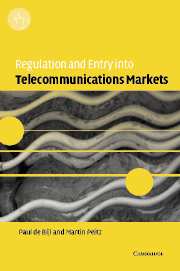Book contents
- Frontmatter
- Contents
- List of figures
- List of tables
- Preface
- Frequently used symbols
- License agreement and warranty disclaimer
- 1 Introduction
- 2 Telecommunications
- 3 The basic model
- 4 Facilities-based entry in a non-segmented market
- 5 Non-facilities-based entry in a non-segmented market
- 6 Entry in a non-segmented market: alternative pricing strategies
- 7 Non-targeted entry in a segmented market
- 8 Targeted entry
- 9 Concluding remarks
- Appendix: sample simulation program
- Bibliography
- Index
4 - Facilities-based entry in a non-segmented market
Published online by Cambridge University Press: 22 September 2009
- Frontmatter
- Contents
- List of figures
- List of tables
- Preface
- Frequently used symbols
- License agreement and warranty disclaimer
- 1 Introduction
- 2 Telecommunications
- 3 The basic model
- 4 Facilities-based entry in a non-segmented market
- 5 Non-facilities-based entry in a non-segmented market
- 6 Entry in a non-segmented market: alternative pricing strategies
- 7 Non-targeted entry in a segmented market
- 8 Targeted entry
- 9 Concluding remarks
- Appendix: sample simulation program
- Bibliography
- Index
Summary
Introduction
The previous chapter presented the basic model and results based on analysis and simulation in a static context. This chapter introduces dynamics into the model. Operators compete during several periods, which allows us to analyze a telecommunications market from its infancy to its maturity. In this chapter, we look at facilities-based entry (the entrant has a network consisting of a long-distance backbone and a customer access network).
The model used to analyze facilities-based entry is a repeated version of the basic model of Chapter 3. Operator 2 represents, for example:
an entrant that has built a customer access network similar to the incumbent's network;
a cable operator that has upgraded its cable network to a two-way communications network
an entrant that uses new technology to build a customer access network that is quite different from the incumbent's network, but enables it to deliver similar services (e.g. wireless local loop).
In reality, these types of entrants may have different cost structures. We assume here, as a starting point, that operator 2's network is similar to the incumbent's, and therefore it incurs identical connection-dependent and traffic-dependent costs. Also, we would expect that costs change over time and that, more importantly, there exists uncertainty with respect to future costs. By keeping costs constant over time, we greatly simplify the regulator's problem if it intends to set price caps.
Part of our analysis considers retail price regulation so that the incumbent is subject to a price cap.
- Type
- Chapter
- Information
- Regulation and Entry into Telecommunications Markets , pp. 87 - 113Publisher: Cambridge University PressPrint publication year: 2003



